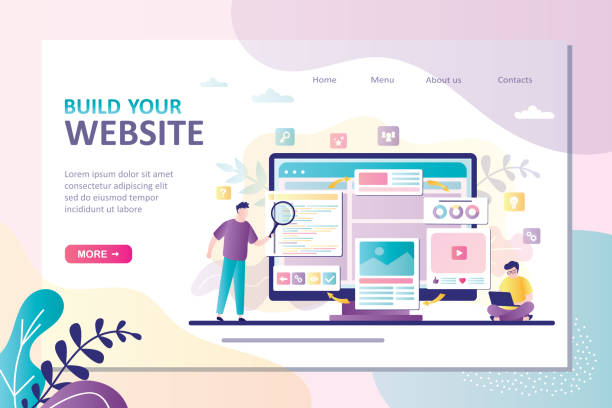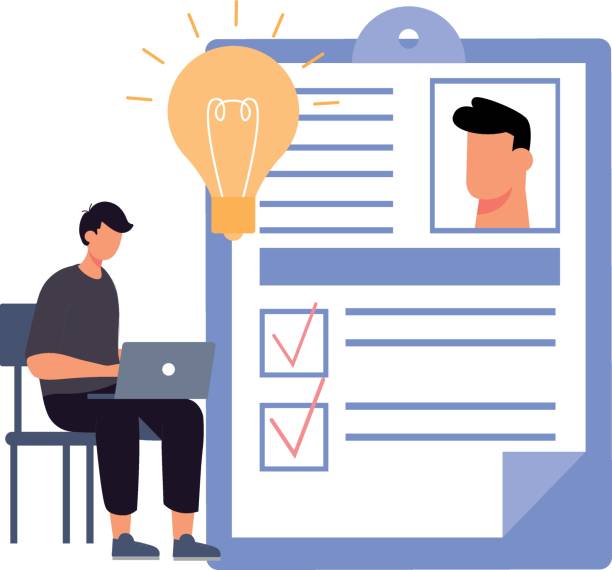Why is Multilingual Website Design a Necessity Today?

In today’s world, where geographical boundaries have no meaning in the virtual space, having a website in only one language is tantamount to closing doors to a vast segment of the global audience.
#Multilingual_website_design is no longer a competitive advantage, but an unavoidable necessity for any business that dreams of expanding and reaching international markets.
A #multilingual_website allows you to communicate with your audience in their native language, which in turn creates a greater sense of trust and closeness.
This strategy not only helps increase #website_traffic, but also improves #user_experience and ultimately, boosts the #conversion_rate.
Given that billions of people worldwide speak languages other than English, ignoring this market segment means missing out on countless opportunities.
The discussion of #internationalization and content localization is not merely about translating words; it involves adapting content, images, formats, and even cultural elements to the target audience.
This analytical approach demonstrates how a successful multilingual website design can build a bridge between your business and different cultures, enabling you to deliver your message to the world with greater clarity and effectiveness.
Furthermore, this can significantly help improve your search engine rankings for various keywords in different languages.
Are you tired of losing business opportunities due to not having a professional corporate website?
Rasaweb, with professional corporate website design, helps you to:
✅ Build a powerful and reliable image for your brand
✅ Convert website visitors into loyal customers
⚡ Get a free consultation right now!
Key Considerations at the Start of the Multilingual Website Design Process

Before diving into the technical aspects of multilingual website design, it is essential to carefully consider key factors.
The first step is to determine your target markets and corresponding languages.
Do you plan to offer services in common languages like Spanish, Chinese, or French, or are you considering more specific markets? This decision will directly impact your choice of tools, translators, and localization strategies.
The second important point is selecting the appropriate URL structure.
Options include country-code top-level domains (ccTLDs) (e.g., .de, .fr), subdomains (es.yoursite.com), or subdirectories (yoursite.com/es), each with its own advantages and disadvantages in terms of SEO and management.
Making a decision at this stage is crucial, as changing it later can be complex and costly.
From a specialized perspective, paying attention to the technical aspects of multilingual SEO, including the correct use of hreflang tags, is highly important for guiding search engines to display the correct content to users in the appropriate language and region.
A principled multilingual website design should begin with these technical details in mind from the outset to prevent future problems and ensure the best performance for your website.
Additionally, ensuring your Content Management System (CMS) is compatible with multilingual capabilities is an important part of these initial considerations.
Content Management and Localization for Multilingual Websites

One of the most challenging aspects of multilingual website design is content management and localization.
Localization does not merely mean literal translation; it involves adapting content to the culture, dialect, and even currency of the target audience.
For example, a joke or idiom in one language might not make sense or even be offensive in another.
This is where the role of native translators and localization specialists becomes prominent.
They can ensure that your message is conveyed correctly and maintains a sense of connection with the audience.
Using a robust Content Management System (CMS) that natively supports multilingual capabilities (such as WordPress with appropriate plugins, or Drupal and Joomla which have built-in support) can greatly simplify the translation management process.
These systems often provide tools for managing different versions of content, translation workflows, and simultaneous updates.
The educational approach in this area includes training the content team to understand the importance of localization and to utilize available tools.
This helps them produce content that is not only linguistically correct but also culturally appropriate and engaging.
An efficient multilingual website design views the localization process as continuous and an integral part of its content strategy.
In the following, a table for comparing translation management tools is provided:
| Feature | Tool X (e.g., Smartcat) | Tool Y (e.g., MemoQ) | Tool Z (e.g., Transifex) |
|---|---|---|---|
| Translation Memory (TM) | Yes | Yes | Yes |
| Terminology | Yes | Yes | Yes |
| CMS Integration | Good | Medium | Excellent |
| File Format Support | Extensive | Extensive | Medium |
| Team Collaboration | Excellent | Good | Excellent |
The Importance of User Experience (UX) in Multilingual Website Design

One of the vital dimensions in the success of multilingual website design is User Experience (UX).
Simply translating content is not enough; it must be ensured that the user’s navigation and interaction experience in each language is as smooth and pleasant as in the original language.
This includes designing a User Interface (UI) that is compatible with different reading directions (e.g., right-to-left for Persian or Arabic, and left-to-right for English).
Additionally, visual elements, icons, and even colors must be chosen to convey an appropriate and positive meaning in all target cultures.
A common mistake is overlooking the importance of fonts and typography in different languages; some fonts may have high readability in one language but appear unreadable or even inappropriate in another.
Responsive design and compatibility with various devices are also important for global users.
The ultimate goal of multilingual website design is to create a familiar and comfortable environment for every visitor, regardless of their native language.
This involves providing clear options for language switching, ensuring fast page loading, and responsive forms and interactions.
Guiding users to find their desired content in their preferred language, through visual and accessible language switch mechanisms, is a key element in successful multilingual UX.
Strong user experience is the foundation for retaining and attracting a global audience.
Are you worried about losing customers because you don’t have a professional e-commerce site?
With e-commerce website design by Rasaweb, forget these worries!
✅ Significant increase in sales and conversion rate of visitors to customers
✅ Professional and user-friendly design that attracts customer trust
⚡ Get a free consultation from Rasaweb
SEO Strategies for Increasing Visibility of Multilingual Websites in Search Engines

SEO (Search Engine Optimization) for a multilingual website design has its own complexities, but if executed correctly, it can yield excellent results.
One of the most important tools is the use of hreflang tags.
These tags tell search engines like Google which version of a page is appropriate for which language or geographical region.
This prevents duplicate content issues and ensures that users see the correct content in their own language in search results.
Aside from hreflang, optimizing keywords for each language is also very important.
Direct translation of keywords is often not enough; separate keyword research must be conducted for each language, as search terms and search volume can vary significantly.
Additionally, building internal and external links appropriate for each language helps increase the website’s authority and ranking in that language.
Setting up geo-targeting in Google Search Console is also crucial for websites that have specific versions for particular geographical regions.
This specialized approach to SEO ensures that your efforts in multilingual website design lead to maximum visibility in search engines.
Furthermore, continuous monitoring of SEO performance for each language, and making necessary adjustments based on analytical data, is an integral part of a successful strategy.
Technical Implementation Methods for Multilingual Website Design
![]()
For the technical implementation of multilingual website design, there are three main approaches, each with its advantages and disadvantages: subdomains, subdirectories, and country-code Top-Level Domains (ccTLDs).
Subdirectories (e.g., yoursite.com/es/): This method is often recommended for SEO because all languages reside under one main domain, sharing domain authority among them.
Their implementation and management are relatively simple.
Subdomains (e.g., es.yoursite.com): Although search engines consider them as separate entities, they are a popular choice due to the ease of hosting different content on separate servers (if needed) and geographical segregation.
Country-code Top-Level Domains (ccTLDs) (e.g., yoursite.de): This method provides the strongest geographical signal to search engines and is ideal for businesses highly focused on local markets.
However, the need to purchase and manage multiple domains and potentially separate hosting makes it more expensive and complex.
Choosing the right method depends on your business goals, budget, and technical resources.
It is important that every decision is made with expert consultation in web architecture and SEO to ensure that your multilingual website design has a correct foundation.
These technical explanations will help you make more informed decisions for your project and avoid potential complexities in the future.
This specialized process requires a deep understanding of how search engines interact with different URL structures.
Challenges and Solutions in Multilingual Website Design

Despite numerous advantages, multilingual website design also comes with challenges.
One of the most important challenges is maintaining the quality and consistency of translations over time.
Content is constantly being updated, and ensuring that all language versions remain current can be difficult.
The solution is to use Translation Management Systems (TMS) that have Translation Memory and Glossary capabilities.
These tools help maintain consistency and reduce translation costs.
Another challenge is addressing cultural and legal differences in various regions.
What is acceptable in one country may not be in another.
This is where the role of an expert localization team, not just a translator, becomes prominent.
They can identify sensitive cultural points and adapt the content to be culturally appropriate.
Additionally, issues related to data privacy and local laws (such as GDPR in Europe) must be considered.
A practical tip is to always conduct comprehensive User Acceptance Testing in each language and region before launch.
This helps identify potential problems before they reach end-users.
Successful multilingual website design requires a comprehensive and proactive approach that encompasses not only technical aspects but also cultural and legal considerations.
This informative approach emphasizes practical aspects and available solutions.
In the following, a table for the most common challenges and their solutions in multilingual website design is provided:
| Challenge | Description | Solution |
|---|---|---|
| Translation Quality | Poor machine translations, cultural mismatch. | Use specialized native translators, TMS tools with TM and Glossary. |
| International SEO | Incorrect content display in search, hreflang issues. | Correct hreflang implementation, separate keyword research for each language. |
| Content Management | Maintaining and updating multiple content versions in different languages. | Use a multilingual CMS, define translation workflows. |
| User Experience (UX) | Inappropriate design for different reading directions, unsuitable fonts. | Flexible UI/UX design, user testing in each language. |
| Legal and Cultural Issues | Non-compliance with local laws (GDPR), overlooking cultural sensitivities. | Consult with legal and cultural specialists, localization beyond translation. |
Global Expansion and Business Opportunities with a Multilingual Website

A multilingual website design is not merely a technical investment; it is a powerful strategy for market expansion and revenue growth.
By reaching audiences worldwide in their native language, businesses can significantly expand their customer base and enter new markets that were previously inaccessible to them.
This means a potential increase in sales, stronger branding, and greater loyalty among international customers.
When a user can easily find information about your product or service in their own language, their likelihood of purchasing or interacting increases significantly.
This analytical approach demonstrates how multilingual websites enable companies to lead in global competition.
Furthermore, this approach helps collect valuable data from different markets, which can be used to improve products and services and personalize marketing strategies in the future.
As an engaging piece of content, imagine how appealing it is for a customer from Japan or Germany to be able to interact with your website as if it were designed specifically for them.
This sense of familiarity and comfort goes beyond a simple transaction; it leads to the creation of long-term relationships with global customers.
Multilingual website design is a gateway to countless business opportunities and sustainable growth in the digital age.
Does your current website showcase your brand’s credibility as it should? Or does it scare away potential customers?
Rasaweb, with years of experience in designing professional corporate websites, is your comprehensive solution.
✅ A modern, beautiful, and brand-identity-aligned website
✅ Significant increase in lead generation and new customers
⚡ Contact Rasaweb now for a free corporate website design consultation!
Future Trends in Multilingual Website Design and Development

The future of multilingual website design is full of innovation and advancement, especially with the emergence and progress of Artificial Intelligence (AI) and Machine Learning (ML).
Neural Machine Translation (NMT) is becoming increasingly accurate and natural, which can help accelerate the localization process.
However, there is still a need for human oversight and editing to maintain quality and cultural accuracy.
From a thought-provoking perspective, one might ask: Can AI someday completely eliminate the need for human translators? While the answer is currently no, advancements indicate that the role of translators will shift more towards review, editing, and deeper localization.
Another important trend is content personalization based on the user’s language and geographical location.
By utilizing user data and AI technologies, websites can dynamically adapt their content based on linguistic preferences, location, and even previous user behavior.
This elevates the user experience to a new level and enhances engagement.
Furthermore, the increasing use of voice search and virtual assistants in various languages highlights the need for optimizing content for conversational search.
Multilingual website design in the future, by integrating these novel technologies, will become smarter and more dynamic, providing an unparalleled experience for global users.
Final Tips and Key Recommendations for a Successful Multilingual Website Design

To achieve a successful multilingual website design, summarizing key tips and recommendations is essential.
Firstly, meticulous planning before starting the project is of paramount importance.
Determining target markets, languages, and technical structure (subdomain, subdirectory, or ccTLD) should be done at the very beginning.
This planning serves as a comprehensive guide.
Secondly, investing in quality translation and localization, not just machine translation, is vital.
Using native translators and cultural specialists ensures that your message is conveyed correctly and respectfully to different cultures.
Thirdly, paying attention to international SEO and correctly using hreflang tags, along with keyword research for each language, significantly helps your website’s visibility in search engines.
Fourthly, do not underestimate the importance of multilingual User Experience (UX).
Responsive design, appropriate fonts, and a user interface adapted to different reading directions are essential for retaining users.
Finally, continuous maintenance and updates of the multilingual website, including content updates and performance monitoring, are key to sustained success.
Multilingual website design is an ongoing process that requires attention to detail and long-term commitment, but its reward will be access to global markets and unprecedented growth for your business.
This explanatory approach is to ensure maximum returns from your website.
Frequently Asked Questions
| Question | Answer |
|---|---|
| 1. What is multilingual website design? | The process of creating a website whose content is available in multiple different languages so that users from around the world can interact with the site in their own language. |
| 2. Why should we make our website multilingual? | To expand the market, attract international audiences, improve SEO in global search results, and increase brand credibility and professionalism. |
| 3. What are the methods for implementing a multilingual website? | Using subdomains (e.g., fa.example.com), subdirectories (e.g., example.com/fa/), URL parameters (e.g., example.com?lang=fa), or country domains (e.g., .ir, .de). |
| 4. Is multilingual website SEO different? | Yes, it requires international SEO strategies such as using hreflang tags, an appropriate URL structure for each language, and keyword research for each language. |
| 5. What points should be considered when choosing languages? | Language selection should be based on the target market, audience demographics, and current website traffic analysis data. |
| 6. What are the common problems in multilingual website design? | Problems related to SEO, translation quality, content management, right-to-left (RTL) and left-to-right (LTR) support, and user experience. |
| 7. What is the role of CMS in multilingual websites? | Modern Content Management Systems (CMS) (such as WordPress with multilingual plugins or Drupal) offer built-in features or powerful plugins for easy content management in multiple languages. |
| 8. How should content translation be done? | Translation should be done by native and professional translators, not just machine translation, to ensure proper tone, culture, and local idioms are respected. |
| 9. How is language switching done on multilingual websites? | Typically, a Language Switcher is used in the header or footer of the site, allowing users to easily select their desired language. |
| 10. Is responsive design important for multilingual websites? | Yes, responsive design ensures that the site is displayed correctly on any device (mobile, tablet, desktop), which is crucial for international user access and SEO. |
And other services of Rasaweb Advertising Agency in the field of advertising
Smart Data Analysis: An innovative platform for improving user engagement with custom programming.
Smart UI/UX: Professional optimization for campaign management using custom programming.
Smart Direct Marketing: An effective tool for campaign management with the help of custom programming.
Smart Advertising Campaign: An innovative platform for improving customer acquisition by customizing user experience.
Smart Marketing Automation: A dedicated service for growing user engagement based on precise audience targeting.
And more than hundreds of other services in the field of internet advertising, advertising consultation, and organizational solutions
Internet Advertising | Advertising Strategy | Advertorials
Resources
Importance of Multilingual Website Design
SEO Guide for Global Websites
Choosing the Best Platform for a Multilingual Website
Strategies for Global Online Business Expansion
❓ With the specialized services of “Rasaweb Afarin” Digital Marketing Agency, from secure and attractive website design to professional optimization, achieve your digital marketing goals and establish a powerful online presence.
📍 Tehran, Mirdamad Street, next to Central Bank, Kazeroon Jonoubi Alley, Ramin Alley, No. 6



